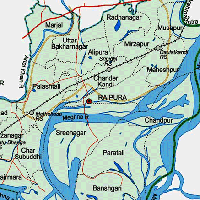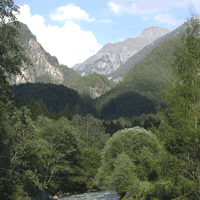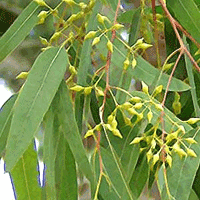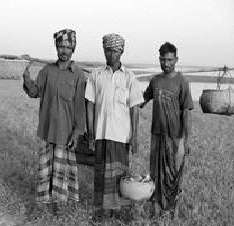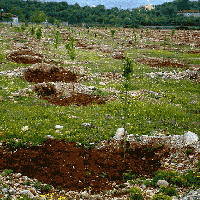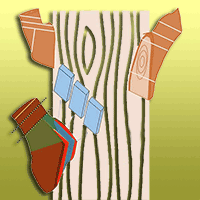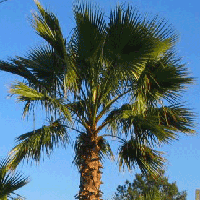
The role of palm husbandry in the rural economy of the south-eastern region of Bangladesh
iForest - Biogeosciences and Forestry, Volume 3, Issue 2, Pages 39-43 (2010)
doi: https://doi.org/10.3832/ifor0528-003
Published: Mar 02, 2010 - Copyright © 2010 SISEF
Research Articles
Abstract
An exploratory study was conducted in Feni, a south-eastern district of Bangladesh to explore the role of palm husbandry in the rural economy. A total of 48 households in the study area were interviewed using a semi-structured questionnaire. Based on the total annual income, the farmers were categorized into three groups as high-income group, medium income group and low-income group. Palm tree contributes 26.000 Tk, 22.740 Tk and 18.300 Tk respectively to the three-income group annually (1 US$ = 69 Tk). Palm trees contribute 46% of total annual income to low-income group followed by 19% to medium income group and 14% to high-income group. Incase of overall income of all the respondents, 26% income comes from palm trees. Besides this, palms provide a multitude of useful products ranging from fuelwood to materials for construction, tools and handicrafts. However the poor marketing system result in decreasing the annual return from palm trees. Palm husbandry could be a promising source of rural incomes in Bangladesh if the farmers’ traditional management knowledge was linked to more scientific management practices.
Keywords
Authors’ Info
Authors’ address
Corresponding author
Paper Info
Citation
Rana MP, Islam MS (2010). The role of palm husbandry in the rural economy of the south-eastern region of Bangladesh. iForest 3: 39-43. - doi: 10.3832/ifor0528-003
Academic Editor
Marco Borghetti
Paper history
Received: Nov 03, 2009
Accepted: Jan 18, 2010
First online: Mar 02, 2010
Publication Date: Mar 02, 2010
Publication Time: 1.43 months
Copyright Information
© SISEF - The Italian Society of Silviculture and Forest Ecology 2010
Open Access
This article is distributed under the terms of the Creative Commons Attribution-Non Commercial 4.0 International (https://creativecommons.org/licenses/by-nc/4.0/), which permits unrestricted use, distribution, and reproduction in any medium, provided you give appropriate credit to the original author(s) and the source, provide a link to the Creative Commons license, and indicate if changes were made.
Web Metrics
Breakdown by View Type
Article Usage
Total Article Views: 65473
(from publication date up to now)
Breakdown by View Type
HTML Page Views: 54253
Abstract Page Views: 3507
PDF Downloads: 6663
Citation/Reference Downloads: 23
XML Downloads: 1027
Web Metrics
Days since publication: 5773
Overall contacts: 65473
Avg. contacts per week: 79.39
Citation Metrics
Article Citations
Article citations are based on data periodically collected from the Clarivate Web of Science web site
(last update: Mar 2025)
Total number of cites (since 2010): 4
Average cites per year: 0.25
Publication Metrics
by Dimensions ©
Articles citing this article
List of the papers citing this article based on CrossRef Cited-by.
References
Agroforestry system in Bangladesh with particular reference to economics and tenurial issue. In: “Agroforestry in Asia and the Pacific” (Mellink W, Rao YS, McDickens D eds). RAPA Publications, Thailand, pp. 25-35.
Gscholar
Role of non-wood forest products based cottage industry in the livelihood of forest encroachers in Bangladesh. International Journal of Forest Usufructural Management 7 (1): 59-66.
Gscholar
Role of bamboo based cottage industry in economic upliftment of rural poor of Chittagong, Bangladesh. Journal of Bamboo and Rattan 6 (3): 20-23.
Gscholar
Encyclopedia of agricultural science. Anmol Publications Pvt. Ltd., New Delhi, India, vol. 4, pp. 125-155.
Gscholar
Socio-economic benefits and issues in non-wood forest products use. In: “Report of the international expert consultation on Non-wood forest products”. Non-Wood Forest Products 3, FAO, Rome, Italy, pp. 89-123.
Gscholar
Entrepreneurship in Bangladesh rural industries. Bangladesh Development Studies XII (1-2): 25-58.
Gscholar
Statistical yearbook of Bangladesh. Bangladesh Bureau of Statistics, Ministry of Planning, Government of the Peoples’ Republic of Bangladesh, Dhaka, Bangladesh, pp. 550.
Gscholar
Impact of social forestry practices. In: “Paper presented at a national workshop on social forestry and community development”. Institute of Forestry, Chittagong University (Bangladesh), 5-10 October 1991, pp. 20-31.
Gscholar
Use of Caryota urens in Sri Lanka. In: “First International Sago symposium on the equatorial swamp as a natural resource” (Sarawak TK ed). Kuala Lumpur, Malaysia, pp. 84-90.
Gscholar
Date production and protection. FAO Plant Production and Protection Paper No. 35, Food and Agriculture Organization, Rome, Italy. pp. 127.
Gscholar
The fifth five-year plan (1995-2000 - Government of Bangladesh) Dhaka, Bangladesh. Planning Commission, Ministry of Planning, Government of the Peoples’ Republic of Bangladesh, pp. 345.
Gscholar
Harvesting sap from date palm and Palmyra palm in Bangladesh. In: “Proceedings of the second international conference on date palms”. United Arab Emirates University, Al-Ain, 25-27 March 2001, pp. 73-77.
Gscholar
Case study on status of palm tree production in Feni District. In: B.Sc. (Hons.) Project paper. Department of Forestry and Environmental Science, Shahjalal University of Science and Technology, Sylhet, Bangladesh, pp. 68.
Gscholar
Distribution and productivity of Khejur (Phoenix sylvestris Roxb) in the villages of Chittagong region, Bangladesh. International Journal of Forest Usufructs Management 4 (1): 49-54.
Gscholar
Palm conservation: its antecedents, status and needs. In: “World Palm Symposium”. Fairchild Tropical Botanical Garden (Miami, FL) 20-21 October 1995, UAE, pp. 135.
Gscholar
Palms: their conservation and sustained utilization. IUCN Publications Services Unit-219, Huntington Road, Cambridge, UK, pp. 190.
Gscholar
Fal, Ful and Shack and Sabji. Comilla, East Pakistan. 2nd edition, pp. 330-342. (In Bengali).
Gscholar
Indigenous practice of khejur palm (Phoenix sylvestris) husbandry in rural Bangladesh. Journal of Tropical Forest Science 10 (3): 357-366.
Gscholar
The structure and growth of micro enterprises in southern and eastern Africa. GEMINI Working paper No. 36, Growth and Equity through micro enterprise Investments and Institutions (GEMINI) Project, Bethesda, Maryland, USA.
Gscholar
South Indian fruit and their culture (1st edn). Varadachary & Co., Madras, India, pp. 313.
Gscholar
Plantation crops and organization farming. Rimon Books, Chittagong, Bangladesh, pp. 12-20.
Gscholar
How to cultivate rattan and patipata. Bulletin 6, Minor Forest Products Series, Bangladesh Forest Research Institute, pp 8-12 (in Bengali).
Gscholar
Economic study of Bansods (Bamboo craftsmen) of Mungelii: a case study. Indian Forester 124 (8): 619-624.
Gscholar
Marketing, valuation and pricing of NWFPS. In: Proceedings of regional expert consultation “Beyond timber: social, economic and cultural dimensions of non wood forest products in Asia and the Pacific” (Durst PB, Bishop A eds). RAP Publication 1995/13, Regional Office for Asia and Pacific Bangkok, FAO/RAP, 28 Nov - 2 Dec 1994, pp. 97-107.
Gscholar
Date palm cultivation. FAO Plant Production and Protection. Paper No. 156, Food and Agriculture Organization, Rome, Italy, pp. 145.
Gscholar

